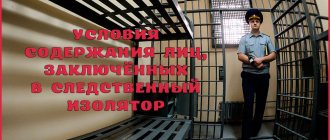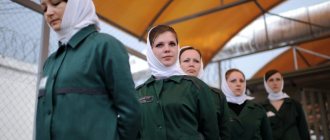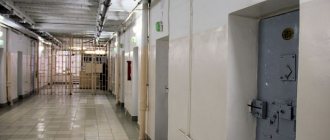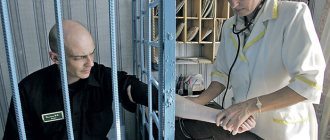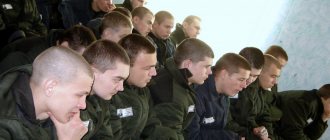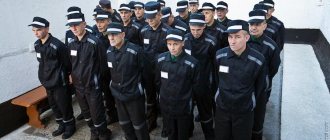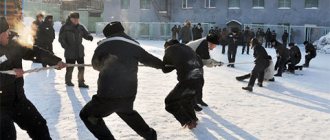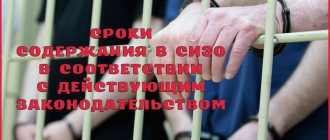Having committed a crime, a citizen must be punished to the fullest extent of the law. Since in our country there is a presumption of innocence, in order to bring an attacker to justice, you must first prove his guilt. Evidence is collected during investigative activities, which often drag on for months.
While the investigation is ongoing, the suspect can hide in an unknown direction, avoiding fair punishment. To prevent this from happening, a citizen can be placed in a temporary detention center for suspects and accused. A temporary detention facility is a closed-type institution, which many compare to a pre-trial detention center. However, there are no less differences than similarities.
What is IVS
Such detention centers are used to hold persons suspected and accused of committing crimes. For example, a criminal may end up here for whom the court has not yet chosen a preventive measure. Accordingly, the IVS is designed for short-term isolation.
The following persons are in the temporary detention center:
- detainees and awaiting sentencing;
- received an administrative penalty in the form of detention for 15 days;
- transferred from the pre-trial detention center for the duration of investigative measures.
Temporary detention center: what is it?
We are talking about a special room in the police department where detained persons are sent. The temporary detention center can be located either in the building of the Ministry of Internal Affairs or in a separate building located nearby.
Previously, instead of temporary detention facilities, there were pre-trial detention cells or pre-trial detention centers. This abbreviation is used by ordinary citizens and law enforcement officers to this day. However, this name is incorrect, because officially detainees are sent to a temporary detention center.
Those who most often end up in temporary detention centers are those whose fate has not yet been decided at the time of detention. That is, subsequently the person can either be released or arrested. Also, an accused who was decided to be kept in custody at the pre-trial stage of the investigation may end up in such a detention center. However, keeping such persons in temporary detention facilities is a last resort. This is only possible if there is no pre-trial detention center nearby.
You can also end up in a temporary detention center as a result of committing an administrative offense. For example, a person received 10 days of arrest. In this case, he is sent to a temporary detention facility. The maximum period of detention is 15 days. As a rule, the isolation wards where arrested persons are placed are called special detention centers.
If a foreigner has violated immigration laws, he will be deported to his home country. Until this moment he is in custody. Foreign citizens are kept separately from other detainees. These institutions are called SUVSIG.
In addition, persons arrested for administrative violations are also kept separately from those citizens who are only suspected of committing a crime. However, local departments of the Ministry of Internal Affairs may decide on joint maintenance. This is possible in small settlements where there are no special detention centers. In large cities, such institutions are usually located in separate buildings and located in a fenced area.
What is a pre-trial detention center?
We are talking about a pre-trial detention center with 24-hour security. It contains the following persons:
- citizens under investigation but not yet convicted;
- criminals who have awaited a court decision but are awaiting transportation to prison;
- persons awaiting extradition.
Transfers to the isolation ward
Detainees can receive parcels and parcels from relatives, and their number is not limited. The only thing is that the weight of the transfer to the temporary detention facility should not exceed thirty kilograms per month. However, the weight is not limited when it comes to parcels for minors, mothers with infants or seriously ill people.
There is a list of things and products that will not be accepted into the temporary detention facility. Among them: personal food products, unlabeled products, expired or spoiled, seasonings, sweets, alcohol, narcotic and psychotropic substances, medications without a medical prescription, cans and pressure sprayers, sharps, cash, phones and chargers for them, SIM cards, erotic magazines, gel pens, lighters.
For attempting to transfer prohibited items from the list, the violator faces a fine of 3 to 5 thousand rubles. Accordingly, these items or products will be confiscated.
Differences between a temporary detention facility and a pre-trial detention center
Both detention centers are classified as places of deprivation of liberty. However, there are several important differences between them:
- The main difference concerns belonging to certain structures. The temporary detention facility belongs to the Ministry of Internal Affairs, while the pre-trial detention center belongs to the Federal Penitentiary System.
- Temporary detention facilities are not intended for long-term detention of prisoners.
- If a citizen has the status of a detainee, then he is placed in a temporary detention facility. It is prohibited to send detainees to a pre-trial detention center, since the detention procedure itself is not considered a preventive measure.
Criminal procedural terms
When a citizen is detained, he is taken to the police station. What happens next is:
- The suspect can be detained for a maximum of two days, placed in a temporary detention facility.
- After 48 hours, the citizen must either be released or the period of detention extended. The maximum period of detention in a temporary detention facility is 120 hours.
- A suspected citizen can be transferred to a pre-trial detention center at the request of the investigative department or the inquiry body. This will require a court order of arrest.
- If a citizen does not receive the status of an arrested person, he is released from custody no later than 120 hours after being in the temporary detention facility.
If a citizen was transferred to a pre-trial detention center from a temporary detention facility, he cannot be kept there for more than 10 days within one month. In rare cases, the duration of continuous stay in a pre-trial detention center can be up to 20 days. However, this requires a corresponding court order.
Duration of maintenance
The temporary detention center has harsh, almost prison-like conditions. Therefore, citizens are prohibited from being kept here for too long. If a citizen has not been sentenced to prison, then the maximum terms of his detention are determined by the Criminal Procedure Code of the Russian Federation.
At the moment, a person cannot be held in a temporary detention facility for more than 48 hours. This is how much time is given to investigators to search for evidence and initiate a criminal case. If there is no evidence of guilt, the suspect must be released.
The main problem is that it is impossible to carry out the necessary investigative actions in full in such a short period of time. Therefore, in urgent cases, the deadlines can be extended by 72 hours. Therefore, it is possible to extend the maximum period of detention to five days.
The countdown of the detention period begins with the actual restriction of the citizen’s freedom. This point must be reflected in the protocol.
If a suspect is transferred to a temporary detention center from a pre-trial detention center to carry out certain investigative actions, then he can be kept in the detention center for no more than 10 days per month. For persons in special detention centers, the terms of detention are determined by a court decision. In this case, the time spent in the cell after arrest will be counted towards the total term of serving the sentence.
Features of detention in temporary detention facilities
Despite the fact that such detention centers are under the jurisdiction of the Ministry of Internal Affairs, they are not much different from ordinary prisons. The chamber is a closed room equipped with plumbing fixtures. Of the furniture, there are always two beds. Walks and cultural programs are held in specially equipped boxes.
Thus, suspects are kept in fairly harsh conditions.
Special conditions of detention in temporary detention facilities
If minors are placed in a temporary detention center, they are assigned to special cells, the living conditions in which are more comfortable. If signs of an infectious disease are detected in a detained citizen, he is placed in a quarantine box. The duration of quarantine is determined by a health care worker.
Arrangement of cameras
Temporary detention cells are small rooms designed to hold 8-10 people at a time. They are often overcrowded, and therefore the norms for the area allocated to one detainee are met from case to case.
The premises have a harsh environment. As a rule, bunk beds are installed here. Sometimes the sleeping quarters are represented by benches. Also, the temporary detention facility must have a table intended for eating. All furniture is securely screwed to the floor. There are no removable parts.
More lenient conditions may be found in special detention centers where violators are serving administrative sentences. In addition to the table and beds, there may be a toilet with a washbasin. The truth is that those arrested can only dream about hot water. In winter, such cells are heated.
Most chambers have a small barred window. The cells are locked, and a special small window located in the door is used to dispense food.
Items allowed in temporary detention facilities
While in a temporary detention center, citizens can count on three meals a day. Detainees may have the following things with them:
- bedding (mattress, blanket, pillow);
- towel;
- bed linen (pillowcase and two sheets);
- a safety razor (issued to a suspect no more than twice a week with the permission of the head of the temporary detention facility);
- laundry soap;
- toilet paper;
- cutlery, dishes (spoon, mug, bowl).
Each citizen held in a temporary detention facility is provided with bed linen and cutlery. In addition, suspects can count on the following items:
- checkers, backgammon, dominoes or chess (issued by order of the head of the temporary detention facility);
- books, newspapers;
- cleaning items;
- personal hygiene items.
The procedure for placement in an isolation ward
Citizens are admitted to the temporary detention center around the clock. This is done by law enforcement officers - the detention center duty officer or the 24-hour police officer on duty.
When a suspect is admitted, the detention center staff checks the documents that constitute the basis for placing this person in a temporary detention facility, interrogates the detainee, records his testimony and compares it with what is written in the above-mentioned documents.
Such documents may be either a protocol of detention, or a decision of the prosecutor or judicial authorities to place the person in custody.
In addition, the personal documents of the suspect, if any, are checked. If the detainee has any bodily injuries, law enforcement officers draw up a special report on their presence.
This document must be signed by the temporary detention facility duty officer, the person who delivered the suspect to the temporary detention facility, and directly by the detainee himself. The latter is also given a copy of this act.
If the physical impairment of the detainee is serious enough, then he cannot be placed in an isolation ward and is taken to the hospital.
When women with children are admitted to the detention center, birth certificates of the children must be presented, which indicate the blood relationship between mother and child, or a special statement drawn up by the interrogating officer, prosecutor or judge, which states that the woman with children is admitted to the temporary detention facility.
Persons placed in isolation are subject to a search, photographing and fingerprinting. In addition, during the first day of stay in the temporary detention facility, all prisoners must undergo sanitary and hygienic treatment in the shower or bathhouse available on the territory of the detention center. Items of clothing are disinfected. After these procedures, detainees receive bed linen.
Camera equipment
The isolation cells are equipped as follows:
- beds for each suspect;
- tables and benches corresponding to the number of beds;
- closet;
- toilet and washbasin, separated by a small wall from the chamber;
- shelf for toiletries;
- container with drinking water;
- hanger intended for outerwear;
- button to call the attendant;
- urn;
- lamp;
- hood;
- basins for hygienic purposes or washing.
In the cells intended for women with children, there are also children's beds.
Have a question for a lawyer? Ask now, call and get a free consultation from leading lawyers in your city. We will answer your questions quickly and try to help with your specific case.
Telephone in Moscow and the Moscow region: +7
Phone in St. Petersburg and Leningrad region: +7
Free hotline throughout Russia: 8 (800) 301-39-20
Procedure for receiving detainees
Temporary detention centers admit violators on a permanent basis. The institution operates around the clock. There are no weekends or breaks here.
The admission procedure involves the following steps:
- The applicant is examined.
- If there are injuries on the body of the detainee, the detention center employee draws up a corresponding report. In it, he reflects the severity of the injuries and their nature. If a person needs medical care, he is hospitalized in a medical facility under police escort.
- The detainee is photographed, fingerprinted, and subjected to a full personal search, during which all items are confiscated, clothing and shoes are examined.
- If temporary detention facility employees suspect attempts to bring prohibited items into the cell, they have the right to rip open the detainee’s shoes and tear the clothes of the detainee. In addition, during the inspection, prostheses, splints, casts, and bandages may be removed from the citizen.
- All items of the detainee are disinfected, and he himself is sent to the bathhouse.
- After all procedures, the citizen is sent to the cell.
Internal regulations in temporary detention facilities
While in the isolation ward, the detainee spends most of his time in a closed cell, guarded by a convoy. You are allowed to leave the cell only to carry out the following actions:
- Daily walk. Conducted in a fenced area. For minors, the duration of the walk is at least two hours, for adults – at least an hour. The process can be completed ahead of schedule at the request of the detainee.
- Meetings with relatives. Held twice a month. Maximum duration – 3 hours. Permission to visit is issued by a representative of the investigative department or inquiry body.
- Meetings with a lawyer. Can be carried out daily. Duration – no more than two hours.
- Participation in investigative activities. The procedures are carried out at the initiative of the investigator or interrogating officer. The number of procedures is unlimited.
- Visit to the bathhouse. Bath procedures are carried out once a week.
Minor detainees are allowed to attend classes under the supervision of a temporary detention facility officer. Individual training is expected. The teacher visits the temporary detention center at the appointed time.
Details
Raid on temporary detention center
How are temporary holding cells equipped?
You shouldn’t count on comfortable conditions in the cell. The detention center is a small room with a capacity of up to 10 people. Quite often, isolation wards are overcrowded beyond normal.
- Individual beds, bunks;
- In separate cells for women with young children, there are children's beds;
- Table for eating;
- Benches according to the limit of seats in the cell;
- Wardrobe for storing things and food;
- Sanitary facilities with all necessary privacy standards;
- Washbasin with cold water;
- Clothes hanger;
- Radio speaker for broadcasting a national program;
- Duty call button;
- Exhaust ventilation.
All furniture is securely attached to the floor and has no removable parts.
In a special detention center for administrative punishment, there may be additional conditions. The cell also has beds and a table, a toilet and a washbasin.
During the heating season, heat is supplied to any IVS. Depending on the location, the isolator may have a window with bars. The cell door is always locked and there is a special window for serving food.
On a note!
Once a week, defendants are sanitized, showered, and bed linen changed.
Duration of detention in a temporary detention facility
In accordance with the law of the Code of Criminal Procedure of the Russian Federation, persons detained on suspicion of committing a crime are arrested for 48 hours. After this time, the suspect must be:
- Released;
- Arrested by the court and transferred to a pre-trial detention center;
- The period of detention was extended by the court to 72 hours;
- If it is necessary to conduct investigative experiments, the suspect can be detained in a temporary detention facility for up to 10 days.
If a citizen is serving a sentence in a special detention center for an administrative violation, then his term is determined by the court.
Important!
The time spent in a temporary detention facility cell immediately after arrest is counted toward serving the full sentence.
Inner order rules
Detainees may leave their cells only in the following cases:
- Daily walk. Which is carried out in a prepared area. The duration of the walk is 1 hour for an adult, 2 hours for a teenager. If the detainee wishes, the walk can be interrupted earlier.
- To meet with a lawyer. The detainee has the right to daily meetings, lasting up to 2 hours, with his lawyer.
- Meeting with relatives with the permission of the investigative authorities.
- For washing in a bath or shower, once a week.
- For inquiry, investigation, participation in investigative activities.
- For minors, teachers may be invited to teach.
The procedure for transferring personal belongings
The transfer of parcels from relatives is allowed in the temporary detention center. Please note that the total weight of the parcel should not exceed 30 kg.
The weight limit does not apply to the following categories of persons:
- Minors;
- Persons suffering from a serious illness confirmed by a medical certificate;
- Pregnant women or women serving time with a baby.
For teenagers, it is allowed to transfer textbooks and stationery to continue the educational process.
List of prohibited things:
- Piercing and cutting objects;
- Money;Prison
- Lighters;
- Medicines (without medical permission);
- Alcohol, drugs;
- Food products without factory labeling and packaging;
- Phones, sim cards.
All permissible nomenclature is publicly available in the temporary detention facility, where they are accepted, controlled, and weighed.
Important!
Transfers during a meeting with relatives or a lawyer are strictly prohibited.
The difference between a temporary detention facility and a pre-trial detention center
A pre-trial detention center is a 24-hour guarded pre-trial detention center. In which they place:
- Unconvicted citizens who are under investigation;
- Persons who have awaited a court decision and are awaiting further transportation to prison;
- Arrested persons awaiting transport to their homeland.
Pre-trial detention centers are cells that ensure the deprivation of liberty of suspected persons, but are not aimed at correcting the accused, but only to limit contact with others until the circumstances are clarified.
Regime in the temporary detention center
While in a temporary detention facility, a detainee is required to strictly obey internal rules. In case of violation of the established regulations, the citizen will suffer appropriate punishment.
Walks
The duration of walks may vary depending on weather conditions, prisoners’ daily routine, cell occupancy and other situations. Pregnant women and women with young children are not limited in the amount of time they can walk.
When moving along the corridors, detainees are prohibited from performing the following actions:
- lift various objects from the floor;
- talk on a mobile phone;
- press the alarm button, panic button;
- write on the walls;
- violate discipline, sing loudly, shout, etc.;
- throw objects over the fence;
- destroy state property.
The walk may be terminated if the following circumstances exist:
- escape of one of the detainees;
- fire;
- disaster;
- mass riots;
- introduction of quarantine.
Date with a lawyer
To obtain a meeting with the detainee, the lawyer must have the following documents with him:
- a paper authorizing a citizen to carry out professional activities;
- an order authorizing work with a specific client.
Temporary detention center employees do not have the right to demand other documents from the defense lawyer.
The prison officer on duty has the right to observe the meeting. However, he has no right to eavesdrop on the conversation. Therefore, the installation of listening devices is prohibited. Evidence obtained in this way will not be accepted in court.
Meeting with relatives
Permission to visit is issued by the investigator or interrogating officer. The document indicates the specific person and the date of visit to the detainee. Permission must be in writing. No more than two people can visit a suspect at the same time.
Hygiene procedures
According to the law, persons detained in a detention center are allowed a shower or bath at least once a week. Each citizen held in a temporary detention facility has at least 15 minutes to take a shower. After hygiene procedures in the isolation ward, bed linen must be changed immediately.
Writing instruments
At the personal request of the offender, he is allowed to be given a ballpoint pen and paper. This is necessary so that the person has the opportunity to express his complaints and claims in writing. This is a direct constitutional right of any citizen of the Russian Federation.
Study for minors
Minors detained and taken to the detention center have the right to receive textbooks and other necessary stationery. This means that the relatives of the detainee have the right to give him a certain list of office supplies.
Such measures are mandatory due to the fact that according to the law of the Russian Federation, every citizen is required to obtain a certificate of secondary general education. Staying in a temporary detention facility cannot interfere with this law. In some cases, with the permission of the head of the detention center or representatives of the prosecutor's office, teachers may be invited to carry out the educational process.
IVS (visual and expressive means of language)
IVS (Visual and expressive means of language)
VISUAL POSSIBILITIES OF VOCABULARY 1.1. “Non-special” lexical means
| Terms | Meaning | Examples |
| Antonyms, Contextual antonyms | Words with opposite meanings. Contextual antonyms - it is in the context that they are opposite. Without context, this contrast is lost. | Wave and stone, poetry and prose, ice and fire... (A. Pushkin.) |
| Synonyms, Contextual synonyms | Words that are close in meaning. Contextual synonyms - it is in the context that they are close. Without context, intimacy is lost | To desire - to want, to have a desire, to strive, to dream, to crave. |
| Homonyms | Words that sound the same but have different meanings. | The knee is the joint connecting the thigh and lower leg; passage in birdsong. |
| Homographs | Different words that match in spelling but not in pronunciation. | Castle (palace) – lock (on the door), Flour (torment) – flour (product) |
| Paronyms | Words that are similar in sound but different in meaning. | Heroic - heroic. |
| Words in figurative meaning | In contrast to the direct meaning of the word, which is stylistically neutral and devoid of imagery, the figurative meaning is figurative and stylistically colored. | Sword of justice, sea of light. |
| Dialectisms | A word or phrase that exists in a certain area and is used in speech by the residents of this area | Draniki, shanezhki, beetroot |
| Jargonisms | Words and expressions that are outside the literary norm, belonging to some kind of jargon - a type of speech used by people united by common interests, habits, and activities | Head - watermelon, globe, pan, basket, pumpkin... |
| Professional - lisms | Words used by people of the same profession | Galley, boatswain, watercolor, easel |
| Terms | Words intended to denote special concepts of science, technology, etc. | Grammar, surgical, optics |
| Book vocabulary | Words that are characteristic of written speech and have a special stylistic connotation. | Immortality, incentive, prevail... |
| Prostorechnaya vocabulary | Words, colloquial use, characterized by some roughness, reduced character | Blockhead, fidgety, wobble |
| Neologisms (new words) | New words emerging to represent new concepts that have just emerged. Individual author's neologisms also arise. | There will be a storm - we will argue And let's be brave with her. |
| Obsolete words (archaisms) | Words displaced from the modern language by others denoting the same concepts. | Fair - excellent, zealous - caring, stranger - foreigner |
| Borrowed words | Words transferred from words in other languages. | Parliament, Senate, Deputy, Consensus |
| Phraseologisms | Stable combinations of words, constant in their meaning, composition and structure, reproduced in speech as entire lexical units. | To be disingenuous - to be a hypocrite, to play dumb - to mess around, to hastily - quickly |
Expressive - emotional vocabulary
| Conversational. | Words that have a slightly reduced stylistic coloring compared to neutral vocabulary, are characteristic of spoken language, and are emotionally charged. | Dirty, loud, bearded |
| Emotionally charged words | Evaluative in nature, having both positive and negative connotations. | Adorable, wonderful, disgusting, villain |
| Words with suffixes of emotional evaluation. | Words with suffixes of emotional evaluation. | Cute, little bunny, little brain, brainchild |
1.2 “Special” lexical means (TROPS)
| List of tropes | Meaning of the term | Example |
| Allegory | Allegory. A trope consisting in an allegorical depiction of an abstract concept using a concrete, life-like image. | In fables and fairy tales, cunning is shown in the form of a fox, greed - in the form of a wolf. |
| Hyperbola | A means of artistic representation based on exaggeration. | The eyes are huge, like spotlights. |
| Grotesque | Extreme exaggeration, giving the image a fantastic character. | The mayor with a stuffed head at Saltykov-Shchedrin. |
| Irony | Ridicule, which contains an assessment of what is being ridiculed. A sign of irony is a double meaning, where the truth is not what is directly expressed, but its opposite, implied. | Where are you, smart one, coming from, head? (I. Krylov.) |
| Litotes | A means of artistic representation based on understatement (as opposed to hyperbole). | The waist is no thicker than a bottle neck. (N. Gogol.) |
| Metaphor, expanded metaphor | Hidden comparison. A type of trope in which individual words or expressions are brought together by the similarity of their meanings or by contrast. Sometimes the entire poem is an expanded poetic image. | With a sheaf of your oat hair You belong to me forever. (S. Yesenin.) |
| Metonymy | A type of trope in which words are brought together by the contiguity of the concepts they denote. A phenomenon or object is depicted using other words or concepts. For example, the name of the profession is replaced by the name of the instrument of activity. There are many examples: transfer from a vessel to its contents, from a person to his clothes, from a locality to residents, from an organization to participants, from an author to works. | It will take me forever, When Pero, my joy, falls asleep forever... (A. Pushkin.) I ate on silver and gold. Well, eat another plate, son. |
| Personification | This is an image of inanimate objects in which they are endowed with the properties of living beings, the gift of speech, the ability to think and feel. | What are you howling about, wind? night, Why are you complaining so madly? (F. Tyutchev.) |
| Periphrase (or paraphrase) | One of the tropes in which the name of an object, person, phenomenon is replaced by an indication of its most characteristic features, enhancing the figurativeness of speech. | King of beasts (instead of lion) |
| Synecdoche | A type of metonymy consisting in transferring the meaning of one object to another based on the quantitative relationship between them: part instead of the whole; whole in the meaning of part; singular in the meaning of general; replacing a number with a set; replacement of a specific concept with a generic one. | All flags will be visiting us. (A. Pushkin.); Swede, Russian stabs, chops, cuts. We all look at Napoleons. |
| Comparison | A technique based on comparing a phenomenon or concept with another phenomenon. | The ice, hardened on the chilly river, lies like melting sugar. |
| Epithet | Figurative definition; a word that defines an object and emphasizes its properties. | The grove dissuaded golden with Birch's cheerful tongue. |
2.FIGURATIVE POSSIBILITIES OF SYNTAX 2.1. “Non-special” syntactic means
| 1. Rows of homogeneous members of a sentence. | When an empty and weak person hears flattering feedback about his dubious merits, he revels in his vanity, becomes arrogant and completely loses his tiny ability to be critical of his actions and his person. |
| 2. Sentences with introductory words, appeals, isolated members. | Probably, there, in my native places, just as in my childhood and youth, the baths bloom in the swampy backwaters and the reeds rustle, making me with their rustle, with their prophetic whispers, the poet that I became, that I was, that I will be, when I die. |
| 3. Quoting 4. Different forms of speech: dialogue, monologue, direct speech. | - Well? Is it true that he is so good-looking? - Surprisingly good, handsome, one might say. |
| 5. Expressive use of sentences of various types (complex, complex, non-union, single-part, incomplete, etc.). | They speak Russian everywhere; this is the language of my father and my mother, this is the language of my nanny, my childhood, my first love, almost all the moments of my life that entered my past as an integral property, as the basis of my personality. |
2.2 “Special” syntactic means (figures of speech)
FIGURES OF SPEECH is a generalized name for stylistic devices in which a word, unlike tropes, does not necessarily have a figurative meaning.
| Figure | Meaning of the term | Example |
| Anaphora (or one-beginning) | Repetition of words or phrases at the beginning of sentences, poetic lines, stanzas. | I love you, Petra’s creation, I love your strict, slender appearance... |
| Antithesis | Stylistic device of contrast, opposition of phenomena and concepts. Often based on the use of antonyms. | And the new so denies the old!.. It ages before our eyes! Already shorter than the skirt. It's already longer! |
| Gradation | Graduality is a stylistic means that allows you to recreate events and actions, thoughts and feelings in the process, in development, in increasing or decreasing significance. | I don’t regret, I don’t call, I don’t cry, Everything will pass like smoke from white apple trees. |
| Inversion | Rearrangement; a stylistic figure consisting of a violation of the general grammatical sequence of speech. | He passed the doorman like an arrow and flew up the marble steps. |
| Lexical repetition | Intentional repetition of the same word in the text. | Forgive me, forgive me, forgive me! And I forgive you, and I forgive you. I don’t hold any grudges, I promise you that, But only you will forgive me too! |
| Pleonasm | Repetition of similar words and phrases, the intensification of which creates a particular stylistic effect. | My friend, my friend, I am very, very sick. |
| Oxymoron | A combination of words with opposite meanings that do not go together. | Dead souls, bitter joy, sweet sorrow, ringing silence. |
| Rhetorical question, exclamation, appeal | Techniques used to enhance the expressiveness of speech. A rhetorical question is asked not with the goal of getting an answer, but for the emotional impact on the reader. | Where will you gallop, proud horse, and where will you land your hooves? (A. Pushkin.) What a summer! What a summer! Yes, it's just witchcraft. (F. Tyutchev.) |
| Syntactic parallelism | A technique consisting in similar construction of sentences, lines or stanzas. | I look to the future with fear, I look at the past with longing... |
| Default | A figure that leaves the listener to guess and think about what will be discussed in a suddenly interrupted statement. | You'll be going home soon: Look... So what? To tell the truth, no one is very concerned about my fate. |
| Ellipsis | A figure of poetic syntax based on the omission of one of the members of a sentence, easily restored in meaning. | We turned villages into ashes, cities into dust, and swords into sickles and plows. (V. Zhukovsky.) |
| Epiphora | A stylistic figure opposite to anaphora; repetition of a word or phrase at the end of poetic lines. | Dear friend, even in this quiet House Fever strikes me. I can’t find a place in a quiet House Near a peaceful fire. (A. Blok.) |
| Parcellation is a stylistic technique of dividing a phrase into parts or even individual words in a work in order to give the speech intonation expression through its abrupt pronunciation. | Liberty and Fraternity. There will be no equality. Nobody. No one. Not equal. Never. (A. Volodin.) He saw me and froze. Numb. He fell silent. | |
| Non-union is a deliberate omission of unions, which gives the text dynamism and swiftness. | Swede, Russian stabs, chops, cuts. People knew: somewhere, very far from them, there was a war going on. If you are afraid of wolves, do not go into the forest. | |
| Polyconjunction - repeating conjunctions serve to logically and intonationally emphasize the members of a sentence connected by conjunctions. | The ocean walked before my eyes, and swayed, and thundered, and sparkled, and faded, and glowed, and went somewhere into infinity. I will either burst into tears, or scream, or faint. |
SOUND EXPRESSIVENESS
| Means | Meaning of the term | Example |
| Alliteration | A technique to enhance imagery by repeating consonant sounds. | The hiss of foamy glasses and the blue flame of punch... |
| Alternation | Alternation of sounds. Change of sounds that occupy the same place in a morpheme in different cases of its use. | Tangent - touch, shine - shine. |
| Assonance | A technique to enhance imagery by repeating vowel sounds. | The thaw is boring to me: the stench, the dirt, in the spring I am sick. (A. Pushkin.) |
| Sound recording | A technique for enhancing the visual power of a text by constructing phrases and lines in a way that would correspond to the picture being reproduced. | For three days I could hear how on the long, boring road the joints were clicking: east, east, east... (P. Antokolsky reproduces the sound of carriage wheels.) |
| Acoustic zhanie | Using the sounds of language to imitate the sounds of living and inanimate nature. | When the mazurka thunder roared... (A. Pushkin.) |

